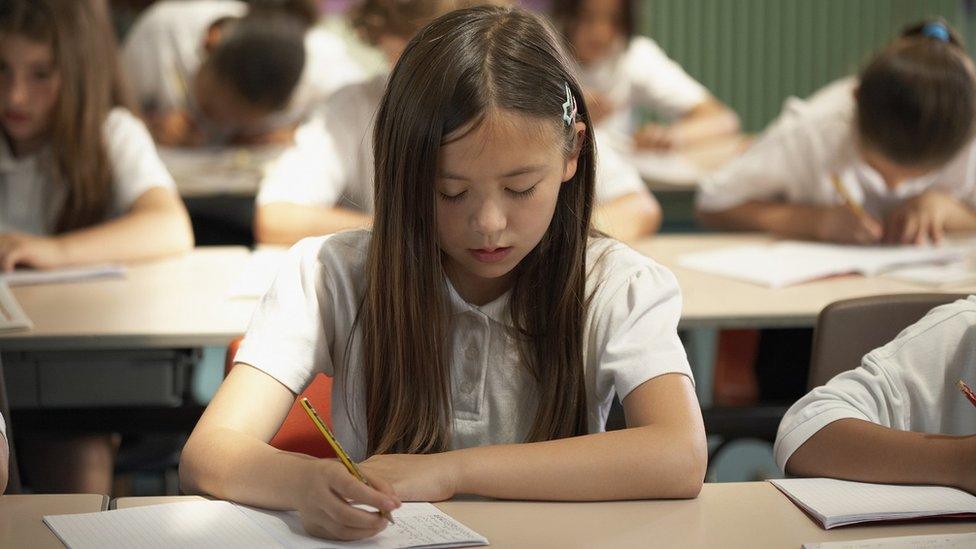Do you have the four reading skills kids need for Sats tests?
- Published

For several days, debate has raged over the complexity of last week's Year 6 Sats reading paper. Some of the children who took it were reportedly in tears afterwards, while the government said that tests are "designed to be challenging".
Many parents and teachers complained that it was simply too difficult for pupils to complete in the required hour, with one head teacher saying it had left her school's "capable" readers "broken".
The test paper, which the Department for Education insists was "rigorously trialled", has now been published., external
So how tough is it exactly?
The marking scheme, which has also been published,, external reveals that 36 of the 38 questions were designed to test three specific reading skills. Pupils who could demonstrate them had the chance to earn a total possible score of 50, but analysis suggests high scores were only possible for those who showed a fourth unspecified ability.
Whatever your age, you can test yourself below and judge whether these skills are a fair expectation for an 11-year-old.
1 - Finding the answers on the page
Possibly the most straightforward questions were those that offered 16 marks for answers where the required skill was to "retrieve and record information or identify key details".
For some questions it was simply a case of finding the correct sentence in a long passage of text and repeating the information, as in these two examples:
Texas in general is a paradise for bats because of all its tasty insects.
Q: The Congress Avenue Bridge attracts bats to Austin. What else attracts bats to Texas?
Many campaigned to have the bat colony eradicated. It was frightening. Back then, we thought they'd attack us by pulling out our hair or that they'd carry disease.
Q: According to Harriet, why did some people in Austin dislike bats? Write two reasons.

Slightly more challenging questions required pupils to piece together the relevant information from two different parts of the text such as these two examples:
The howl pierced the darkening sky and made Innis Munro stop dead in his tracks. He pulled his hood down, [and] listened intently. The only sound was his beating heart. That was a wolf, he thought.
But it couldn't have been. There were no wolves on the island of Nin, no wolves in Scotland any more, not for almost 300 years. It was just a trick of the wind. He pressed on but kept his hood down. The afternoon light of early March was fading fast, snow was falling, and he was still a good half mile from home.
Q: How far from home was Innis when he first heard the wolf howl?
By day, the Congress Avenue Bridge in the city of Austin could hardly look more normal: a grey, dreary city-centre road bridge. By night, it plays host to one of the most amazing shows nature has to offer. The underside of the bridge is home to more than a million bats, and every evening in summer they all come swarming out at once, rising up into the city sky like a tornado before spreading out in all directions like plumes of smoke. Standing on the bridge, you might even feel the wind from their wings as they pass by.
Austin is the capital city of the state of Texas in the USA, but it is also the bat capital of North America.
Q: In which American state is the Congress Avenue Bridge found?
2 - Understanding and explaining what words mean
Nine points were on offer for questions that tested how pupils actually understood words and phrases that were being used. In this case, it was the extent of pupils' general vocabulary that was being tested, such as in these examples:
No, this large number of bats is quite new. A few bats had lived under the bridge for years. It was headline news when they suddenly began moving in by the thousands after engineers rebuilt the Congress Avenue Bridge in 1980 - they had no idea that they were creating such an ideal bat home. So, when these bats first came, they were seen as uninvited guests. Many campaigned to have the bat colony eradicated.
Q: Find and copy one word which means 'a group of bats living together'.
It's true that bats easily outnumber humans in Texas, but they're vulnerable because they live in very large groups.
Q: Harriet describes bats as vulnerable. Which of the following [four terms] is closest in meaning to vulnerable - foolish, at risk, frightening or tormented?
He pressed on but kept his hood down. The afternoon light of early March was fading fast, snow was falling, and he was still a good half mile from home.
Q: What does pressed on mean in the text?
It was the unmistakable silhouette of a wolf.
Q: Which of the following [words] is closest in meaning to unmistakable - unlikely, unfamiliar, possible or definite?

Bats for Sats - the winged mammals were featured in one of the passages on which pupils had to answer questions.
3 - Read it carefully and work out what is going on
The highest number of marks - 23 - was on offer for questions that the marking guide said were designed to show pupils could "make inferences from the text or explain and justify inferences with evidence from the text". This appears to be the hardest reading skill and sometimes requires showing a little life knowledge or "reading between the lines" rather than literally what it says on the page.
These three examples really do require the reader to put themselves in the position of the character:
Priya woke with a start, her heart beating fast. Something had disturbed her but she wasn't sure what. Abby was still sleeping quietly beside her, and the night-light glowed, but now she could see things inside the tent, and she realised that the moon must have risen. She took a deep breath, trying to calm herself, but then she heard something rustling outside.
Q: How can you tell Priya was nervous? Write two ways.
Priya was surprised, and now she was completely awake. They had only seen a couple of cars all day, and now two had come past together.
Q: Why did Priya find it surprising to hear two vehicles drive by?
Very quietly, so as not to wake Abby, she unfastened the zip of the tent. She pulled back the gap and realised she could see the whole valley, blue and black and silver in the moonlight. Directly opposite, on the far side of the valley, she saw two pairs of headlights, not moving.
Q: How can you tell that the moonlight was very bright?

And finally these two questions would be the most likely to trip up an inexperienced reader, as the answers are not actually spelled out in the accompanying text at all, no matter how hard you look. It relies on an average 11-year-old understanding that "it hit her" is an abstract statement rather than a literal description, and explaining how someone would react if they were woken up in the middle of the night
"Then it hit her"
Q: What is "it"?
"You'd better not be making this up."
Q: Why does Abby say this to Priya?
4 - Read at speed and make decisions quickly
The fourth skill is one that was not specifically marked, but close analysis of the paper reveals how vital it would have been for any pupil.
The examples reproduced above were among 38 questions that had to be answered in an hour to earn 50 points - but it is important to stress that the Sats test was not sliced and diced like we have done above.
The pupils were given three passages of text which were respectively 623, 817 and 612 words long - or 2,052 words in total. The Department for Education does not list an expected reading speed for an average 11-year-old, but US educational studies roughly suggest 150 words per minute is a good aim for silent reading at that age. So reading those passages just once would take up 14 minutes.
The 38 questions contain another 1,142 words, and every wise student remembers the advice to read every question twice, so that accounts for another 15 minutes.
So look at those questions above in a fresh light. Once pupils had absorbed each individual question, they had an average of 49 seconds per question to scan back through the relevant passage, work out their answer and write it down.
By comparison, last year's Sats reading test offered three passages with a total word count of 1,563 words and just 35 questions - and pupils then were given the same time of one hour to complete the test. So, a year ago, pupils had the comparative luxury of a minute on average to find and record each answer.
Related topics
- Published18 May 2023

- Published16 May 2023

- Published13 May 2023

- Published11 May 2023

- Published15 May 2023
